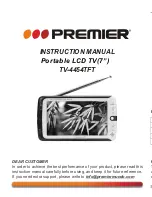
32
EN
5° Disconnect the other end the
positive (+) battery cable to the
battery positive (+) terminal.
6° Connect the vehicle ground cable
to the battery negative (-) terminal.
7° Reconnect the vehicle grounded
battery cable.
HIGH ALTITUDE OPERATION
At high altitude, the standard
carburettor air-fuel mixture will be
excessively rich.
Performance will decrease, and fuel
consumption will increase.
High altitude performance can be
improved by installing a smaller
diameter main fuel jet in the
carburettor and readjusting the pilot
screw. If you always operate the
engine at altitudes higher than 5000
feet (1500 meters) above sea level,
have an authorized generator dealer
perform this carburettor modification.
Even with suitable carburettor jetting,
engine horsepower will decrease
approximately 3,5% for each
1000 foot (300 meter) increase
in altitude. The effect of altitude on
horsepower will be grater than this if
on carburettor modification is made.
NOTICE: If a engine jetted for high
altitude is used at lower altitude,
the lean air fuel mixture will reduce
performance and may over-heat and
seriously damage the engine.
PRE-OPERATION CHECK
1) Engine oil
NOTICE: Engine oil is a major
factor affecting engine performance
and service life. Non-detergent and
2-stroke engine oils will damage the
engine and are not recommended.
Check the oil level BEFORE EACH
USE with the generator on a level
surface with the engine stopped.
Use 4-stroke oil, or equivalent high
detergent, premium quality motor
oil certified to meet or exceed
U.S. automobile manufacturer’s
requirements for Service
Classification SG, SF/CC, CD.
Motor oils classified SG, SF/CC,
CD will show this designation on the
container.
SAE 10W-30 is recommended for
general temperature use. Other
viscosities shown in the chart may be
used when the average temperature
in your area is within the indicated
range.
1. Remove the oil filler cap and wipe
the dipstick clean.
2. Check the oil level by inserting the
dipstick into the filler neck without
screwing it in.
3. If the level is low, add the
recommended oil to the upper mark
on the dipstick.
2) FUEL RECOMMENDATION
1. Check the fuel level gauge.
2. Refill the tank if the fuel is low.
Do not fill above the shoulder of the
fuel strainer.
WARNING:
• Gasoline is extremely flammable
and is explosive under certain
conditions.
• Refuel in a well-ventilated area with
the engine stopped. Do not smoke
or allow flames or sparks in the area
where engine is refuelled or where
gasoline is stored.
• Do not overfill the fuel tank (there
should be no fuel in the filler neck).
After refuelling, make sure the tank
cap is closed properly and securely.
Be careful not to spill fuel when
refuelling. Spilled fuel or fuel vapour
may ignite. If any fuel is spilled, make
sure the area is dry before starting
the engine.
• Avoid repeated or prolonged
contact with skin or breathing of
vapour.
• KEEP OUT OF REACH OF
CHILDREN.
Use gasoline with a pump octane
rating of 86 or higher.
We recommend unleaded gasoline
because it produces fewer engine
and spark plug deposits and extends
exhaust system life.
Never use stale or contaminated
gasoline or oil/gasoline mixture. Avoid
getting dirt or water in the fuel tank.
Occasionally you may hear light
“spark knock) or “pinging” (metallic
rapping noise) while operating under
heavy loads.
This is no cause for concern.
















































